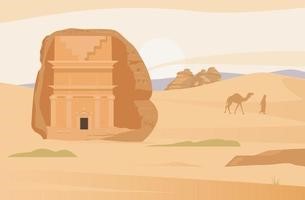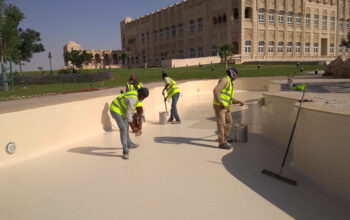
Saudi Arabia, a land of ancient civilizations, dramatic landscapes, and visionary modernity, invites travelers to explore its hidden treasures. From the sandstone tombs of Al Ula to the rugged mountains of Tabuk and the pristine beaches of the Red Sea, this guide unveils the kingdom’s most captivating destinations.
Al Ula: The Living Museum of Arabia
Why Visit?
Al Ula, a UNESCO World Heritage Site, is a symphony of history and nature. Once a hub for Nabatean traders and ancient kingdoms like Dadan and Lihyan, its sandstone cliffs, palm-fringed oases, and archaeological marvels make it a crown jewel of Saudi tourism.
Top Attractions
- Hegra (Mada’in Saleh)
Saudi’s first UNESCO site, Hegra boasts 111 rock-cut tombs, including the iconic Qasr Al-Farid (Lonely Castle), carved by the Nabateans over 2,000 years ago. Guided tours reveal intricate facades and stories of camel caravans that once traversed the Incense Route 19. - Elephant Rock (Jabal AlFil)
This natural wonder, shaped by millennia of erosion, resembles an elephant with its trunk touching the ground. Visit at sunset for golden-hour photography, then unwind at the nearby SALT café . - Al Ula Old Town
Wander through labyrinthine mudbrick streets, traditional souks, and the 10th-century Al Ula Castle. The restored Tantora Square, with its ancient sundial, offers cultural performances and a glimpse into agricultural history. - Maraya Concert Hall
The world’s largest mirrored building, Maraya reflects the desertscape like a mirage. Hosting concerts and exhibitions, it’s a fusion of art and nature. - Adventure Activities
- Hot Air Balloon Rides: Soar over sandstone cliffs and oases at sunrise (SAR 1,200+).
- Rock Climbing & Hiking: Tackle routes in Ashar Valley or stroll the Oasis Heritage Trail.
- Stargazing: Al Gharameel’s dark skies reveal constellations undimmed by light pollution.
Cultural Festivals
Time your visit for events like Winter at Tantora (music and art) or Desert X AlUla (contemporary installations blending with desert vistas).
Travel Tips
- Best Time: October–April (15–25°C) 8.
- Stay: Choose from luxury glamping (e.g., Habitas AlUla) or budget-friendly apartments 1.
- Getting Around: Rent a car (Lumi or Budget) to explore independently 1.
Tabuk: Where History Meets Adventure
Why Visit?
Tabuk, a gateway to Saudi’s northwest, blends ancient forts, mountain treks, and futuristic projects like NEOM. Its strategic location on ancient trade routes adds layers of history.
Top Attractions
- Tabuk Castle
This Ottoman-era fortress houses a museum showcasing relics from the Hijaz Railway and ancient trade routes. Climb its towers for panoramic city views. - Wadi Al Disah
Known as the “Valley of Palm Trees,” this lush canyon features towering cliffs, freshwater springs, and hiking trails. Camp under starry skies for an immersive desert experience. - NEOM & the Red Sea Project
NEOM, Saudi’s $500 billion mega-city, promises futuristic eco-resorts and tech-driven innovations. Nearby, the Red Sea Project offers untouched coral reefs and luxury island getaways. - Tayeb Al Ism (Moses’ Spring)
A tranquil oasis believed to be where Moses struck water from a rock, surrounded by date palms and ideal for picnics.
Adventure Activities
- Off-Roading: Explore Tabuk’s dunes in 4x4s or dune buggies.
- Rock Art Trails: Discover Thamudic inscriptions in Jabal Al Lawz.
Travel Tips
- Combine with Al Ula: A 3.5-hour drive connects these regions 113.
- Stay: Opt for eco-lodges near Wadi Al Disah or modern hotels in Tabuk city.
Beyond Al Ula & Tabuk: Saudi’s Hidden Gems
- Diriyah (Riyadh)
The birthplace of the Saudi nation, Diriyah’s mudbrick ruins and UNESCO-listed At-Turaif district offer a journey into 15th-century Arabia. Don’t miss the Bujairi Terrace for fine dining with views.
- Jeddah’s Al-Balad
This historic quarter, a UNESCO site, enchants with coral houses, bustling souks, and the iconic Floating Mosque. Nearby, Red Sea beaches like Obhur Creek provide snorkeling and yacht charters.
- Al Ahsa Oasis
The world’s largest self-contained oasis, Al Ahsa boasts 2.5 million date palms, Ottoman forts, and the eerie Al Qarah Mountain caves.
- The Empty Quarter (Rub’ al Khali)
Spanning four countries, this vast desert offers overnight safaris, camel treks, and the surreal beauty of rolling dunes 14.
- Farasan Islands
A marine paradise near Jizan, these islands feature coral reefs, migratory birds, and Ottoman-era villages. Ideal for diving and eco-tourism.
Cultural Etiquette & Practical Tips
- Dress Modestly: Women should cover shoulders and knees; men avoid shorts.
- Visa: Apply online for a 1-year, multiple-entry visa (90-day stays) 1.
- Transport: Domestic flights connect major cities; hire drivers for remote areas.
- Cuisine: Savor kabsa (spiced rice with meat), dates, and Arabic coffee.
Conclusion: Saudi Arabia’s Uncharted Magic
From Al Ula’s whispering tombs to Tabuk’s rugged canyons and the Red Sea’s azure waters, Saudi Arabia is rewriting its narrative as a global tourism powerhouse. Whether you’re tracing ancient caravan routes or marveling at mirrored concert halls, this kingdom offers a tapestry of experiences waiting to be unraveled. Pack your sense of adventure—and a camera—to capture the soul of Arabia.
“Traveling—it leaves you speechless, then turns you into a storyteller.” – Ibn Battuta


